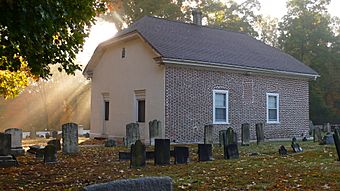Welsh Tract Baptist Church facts for kids
Quick facts for kids |
|
|
Welsh Tract Old School Baptist Church
|
|

Welsh Tract Baptist Church, October 2012
|
|
| Location | Welsh Tract Rd., Newark, Delaware |
|---|---|
| Area | 5 acres (2.0 ha) |
| Built | 1746 |
| NRHP reference No. | 73000527 |
| Added to NRHP | March 1, 1973 |
The Welsh Tract Old School Baptist Church is a very old and important church building. It is located on Welsh Tract Road in Newark, Delaware. Welsh settlers built this church way back in 1746. It is a simple building made of brick with a special kind of roof called a jerkinhead roof.
Contents
The Church's Early History
During the 1600s, there was a lot of religious trouble in England and Wales. Many people, including Baptists, faced difficulties because the government wanted everyone to follow the Anglican church. Because of this, in 1701, sixteen Baptists from Wales decided to move to America. They formed their own church group with Thomas Griffith as their leader.
They sailed from Wales in June 1701 and arrived in Philadelphia in September of the same year. Other Baptist leaders in America suggested they join a church nearby.
The Welsh group stayed near Philadelphia for about a year and a half. They continued to meet as their own church, holding services in each other's homes. They followed their religious practices exactly as they had in Wales. During this time, 21 more people joined their group.
Why the Welsh Baptists Moved Again
The Welsh Baptists had a special practice called "laying on of hands." This was a way of showing that someone was ready to be a church member. Other Baptist churches in Pennsylvania did not practice this. This difference caused some disagreements.
For example, the Welsh Baptists felt they could not share the Lord's Supper with other Baptists who did not believe in "laying on of hands." They tried to work things out in meetings, but it was difficult. In 1706, they agreed that members could visit other churches and that the "laying on of hands" could be discussed freely.
However, the differences continued. Because of these disagreements, the Welsh Baptists decided to find a new home. In 1703, they bought 30,000 acres of land in New Castle County, Delaware. This land was near what is now Newark, Delaware. It was known as the Welsh Tract.
Building the First Church
On this new land, the Welsh Baptists built a small meeting house. Their community became known as the "Emigrant Church." This was partly because of their unique practices, like "laying on of hands" and singing psalms, which were not common among other Baptists at the time.
This first meeting house was used until 1746. That's when the current, larger church building was constructed. Thomas Griffith was the first pastor of the church. He served until he passed away in 1725 when he was 80 years old.
Over time, members from the Welsh Tract Church left to start other Baptist churches in Delaware and other places, like South Carolina. The practices of the Welsh Tract Church became important for many Baptist churches in the Middle States.
Old School and New School Baptists
The Welsh Tract Baptist Church was one of the churches that helped start the Philadelphia Baptist Association. However, in 1836, the Welsh Tract Church left this association. They joined with other churches to form the Delaware River Old School Baptist Association. This happened when Elder Samuel Trott was their pastor.
Why the Split Happened
A big split happened among Baptist churches in America. This was between the "Old School" Baptists and the "New School" Baptists. The "Old School" Baptists believed that churches should only follow practices found directly in the New Testament of the Bible. They did not like new ideas that had become popular.
These new ideas included things like:
- Mission societies (groups that sent missionaries to other places)
- Bible societies (groups that printed and shared Bibles)
- Sunday Schools
- Special training for ministers
- Big revival meetings
The "Old School" Baptists felt these practices were not in the Bible and were not needed. This disagreement led to a full separation in 1832.
Elder Trott, the pastor of Welsh Tract Church, believed that they should follow Christ's example very closely. He felt that many new things introduced among Baptists were not truly helping religion. He wanted to stick to the "safest path" by relying on God's wisdom to spread His message.
Another pastor, Elder Thomas Barton, also spoke against missions and paid ministers in 1832. The "Old School" Baptists believed that God would bring people to faith in His own way. By 1856, their group was officially called "The Delaware Old School Baptist Association."
Today, the Welsh Tract Old School Baptist Church still holds meetings. They meet on the second Sunday of every month. Elder Robert Lackey is the current pastor.
The church does not have its own official website. However, members and friends have created online pages and blogs to share the church's beliefs. There is also a publishing company called Welsh Tract Publications that focuses on "Old School" Baptist principles.
The church property was added to the National Register of Historic Places in 1973. This means it is recognized as an important historical site.




